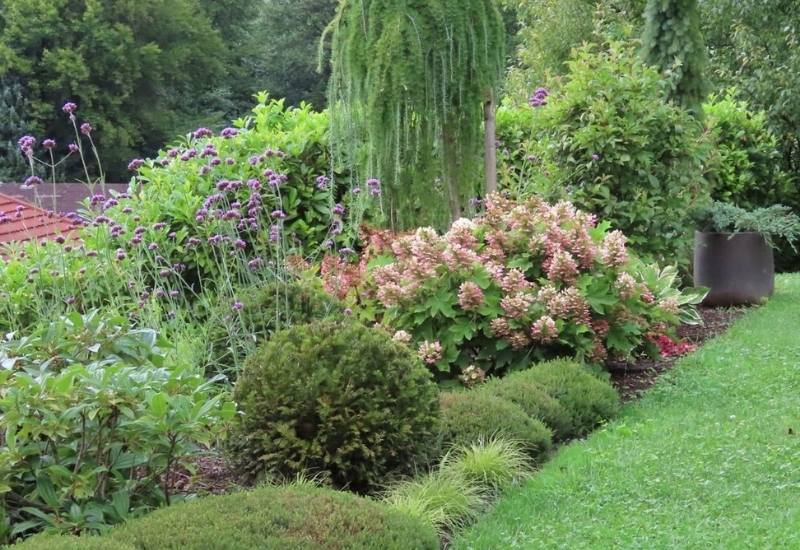
Do you need to block prying eyes or windbreak from your backyard, but don’t want to wait? ? Fast growing shrubs are part of the solution!
Grow privacy bushes with dense foliage that reach eye level quickly then you’ll have a lush green fence in a matter of months… Some will bloom, some will keep their leaves on all year round, but place them bang where they stop others from seeing you and you can finally call your open space fully yours, and very soon indeed!
Fast growing shrubs are excellent to create privacy; many are busy and just tall enough to block the view into your garden without also blocking the Sun. When selecting privacy hedges, there are tried and tested strategies and methods that can optimize your efforts as well.
It’s all a matter of knowing the right sheltering techniques and picking the best fast growing shrub for your needs. And we’ll teach you both right now!
Read on to learn about some of the best fast-growing shrubs for privacy, along with their growing requirements and tips on how to use plants as screens against curious (or just passing) eyes.
Tips For Using Fast Growing Shrubs As Living Privacy Screens
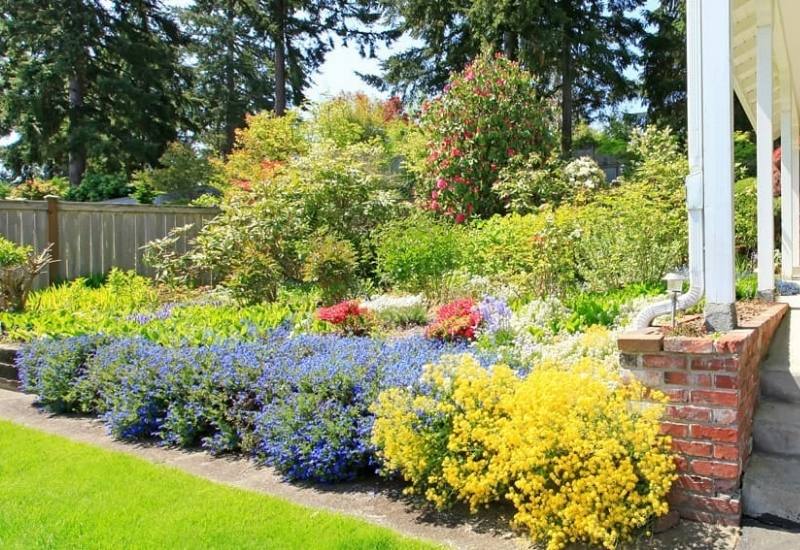
You don’t need to “wall yourself” in to get privacy. If you grow a very tall edge all around your garden you may end up having a dark space, especially if it is small.
Yet again, it may break the natural proportions of your garden. And then there is the problem of pruning and growing tall shrubs and trees.
And you may even get complaints from neighbors, because it also blocks their sunlight.
So, what can you do? I have a few tricks of the trade that professional gardeners use for you…
Choose Where You Want Privacy
You may not need all your garden off view. Most people are happy with a private area, maybe where you entertain guests, where you have benches and tables, or where your children play.
If you have a map of your garden and terrace, mark the area you wish to be fully private on it. Otherwise you can use a mental map, or the real thing…
Find View Lines in the Area You Want to Shelter with Fast Growing Shrubs
Found it? Now go there, on the spot. Look around you and find what we call view lines. These are literally the trajectories of the sight of people.
They are the lines of “the intrusive eyes”. You see, those are what you want to block, not your view out! Block only view lines, which means the views into your garden.
For example, if there is a house in front of you and it has two windows, you just need to block off the windows, not the whole building!
Do Take into Account the Light You will Still Get with Shrubs as View Blockers
The fewer the lines you need to block, the the more light you can let into your garden. But if you have many, you can choose the ones that need to be blocked off fully and those that just need a light screen.
Understand How You Can Use Shrubs to Get Full Blocks and Light Screens
If there is a “steady view line” like a window looking onto your barbecue area, you will want a very thick shrub that blocks them completely off. That will also reduce the sunlight you get though.
If it is a passing view line, where people are in movement as they look in, all you need is a light screen. What do we mean? We mean a shrub where you can look though if you really want, one which has an open and sparse habit, whose foliage and branching is not thick.
Passers by will simply be deterred from looking in, they would need to stop and peek in to watch you, and they simply won’t. You will see figures walking along the road, but they will not look in…
And you will still get plenty of light.
Work Out Where You Need to Plant Fast Growing Shrubs for Privacy
“Easy, in between my private spot and where the viewer is,” you may say. And you are partly right… But only with horizontal view lines.
With horizontal view lines plant fast growing shrubs as close as possible to the viewer’s eyes, face, nose… This gives you more space that you can call private.
But how about with people who look down from a window? That line is not horizontal, it forms a triangle with your garden and the wall of the house where the window is….
Draw it and try to block it… You see, the closer you get to your private spot, the lower the shrub needs to be.
In this case, if you wanted to plant it just outside the window, you would need a shrub that reaches the window’s own height… and sure your neighbor would complain…
This has an advantage though, if the window is on the 2nd floor (about 20 feet or 6 meters high), you don’t need a 20 foot tall shrub, just plant it closer to your private space and you will need a much shorter one. Phew!
Then there are other little tricks that you will enjoy and maybe use.
Lower Your Heads in Your Private Area…
What do we mean? I mean that if you like a private space to sit down, you only need to screen up to about 5 feet (1.5 meters) to get privacy. You don’t need a very tall shrub that may take away lots of light.
Heighten Your Fast Growing Shrubs
“What do you mean, with heighten? You can’t get the to grow taller or faster!” No but… and this is one of my favorite tricks…
I the shrub is small enough and you can grow it in a container, you can add a good foot or two to its height with a nice pot. It’s like giving them platform shoes…
And this way, you can also move them around in case you miscalculate the view lines…
Plant the Shrubs Close to Benches and Tables
If you want a private corner where you can stop and be on your own, maybe out a bench there, and put the shrub just to the back of the bench. This gives you a small but easy and fast “small green place for yourself”.
Focus on Where You Stop, Not Where You Pass
This follows from the point above, in a more general sense, look at how you circulate around the garden, the places you just use in transit don’t need much privacy.
But where you stop to have a coffee or a glass of wine is where you really want to be on your own without curious eyes. Focus on these places.
Use Other Screens as Well, Apart from Fast Growing Shrubs
A little fence, a feature, a trellis, a shed, etc. are all good ways of blocking views, which you can mix in with your fast growing shrubs to keep unwelcome eyes off your garden or terrace.
Think All Year Round, Evergreen and Deciduous Fast Growing Shrubs
Evergreen fast growing shrubs will block the view all year round. Deciduous ones will not, or not as well.
If the branching is thick you will still get a partial block in winter, but if it has an open habit, curious eyes will come back. But maybe you don’t use your green space once it’s turned white with snow, so you won’t care.
Tailor the solution to your needs.
We have gone through the technical tricks and strategies; now it’s time to “talk shop” or “talk shrubs”?
15 Best Fast Growing Shrubs for Quick Privacy in Your Landscape
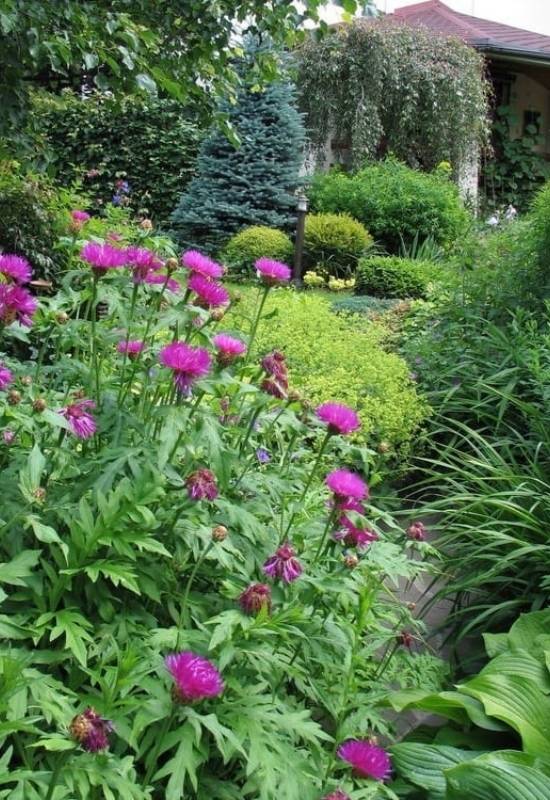
A fast growing shrub is simply a plant that becomes big and fast. The advantage for privacy is obvious; you don’t need to wait for years or decades to screen your private area.
In fact you can get results in a few years, and with some of them, even on the first year. But which ones are the best?
1: Forsythia (Forsythia spp.)
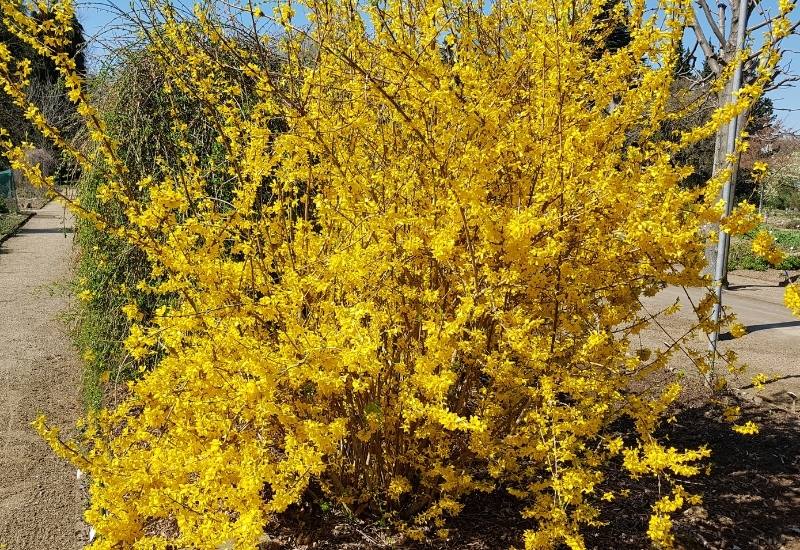
Forsythia is a deciduous flowering shrub that grows super fast. Within a year you will already get a good screen against prying eyes.
The average growth is 2 feet per year (69 cm), after pruning, but the young branches will grow much more, and early in spring already, Then it will fill with its fabulous golden yellow blooms…
And the branches are very thick, so, when the green leaves are on, you get a full “wall” that completely blocks view lines, and when the cold months come, you still get a partial protection of your privacy.
Forsythia is a popular and easy to grow early spring blooming shrub; it looks far better in informal gardens and terraces, but it can be pruned into shape for slightly more formal settings, like urban gardens.
Don’t try to make into topiary though, it is far too vigorous and wild looking for that! It is also fairly large, so ideal for big spaces, but it gives you a simple and quick solution.
2: North Privet (Ligustrum x ibolium)
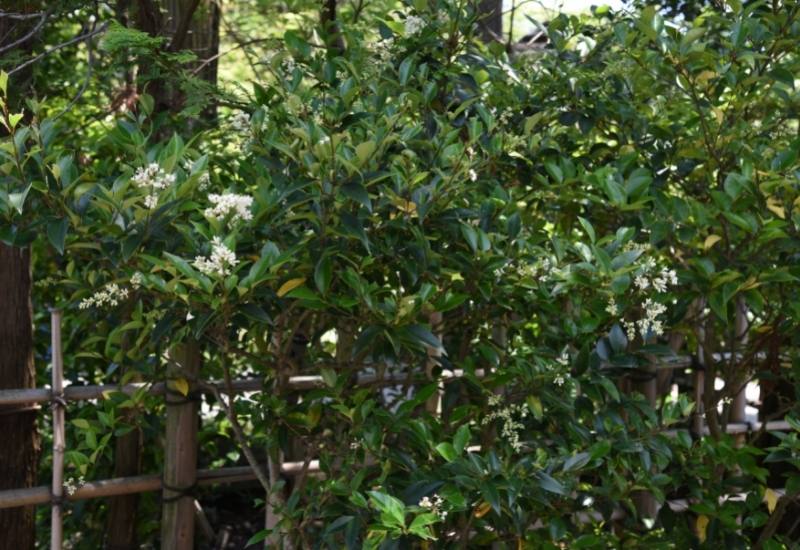
North privet is a fast growing and semi evergreen shrub with a classical look. Dense, mid green little leaves totally cover it, forming a real impenetrable wall to viewers but also to intruders.
It can double as a solid hedge, and it can be shaped very easily. Easy to grow, the more you prune it, the ticker and sturdier it gets. In fact do it at least 3 times a year, to avoid a tall but loose bush with gaps in it.
Allow it to grow about 2 feet (60 cm) every year on the whole. If you live in a fairly warm region, you will also get green foliage all year round.
North privet is ideal for formal gardens and terraces. You can give it any shape you want, including geometrical ones.
You can also keep it to a small size, so you can fit it into containers. The only thing that heightens its maintenance is the regular pruning it needs.
3: Crape Myrtle (Lagerstroemia indica)
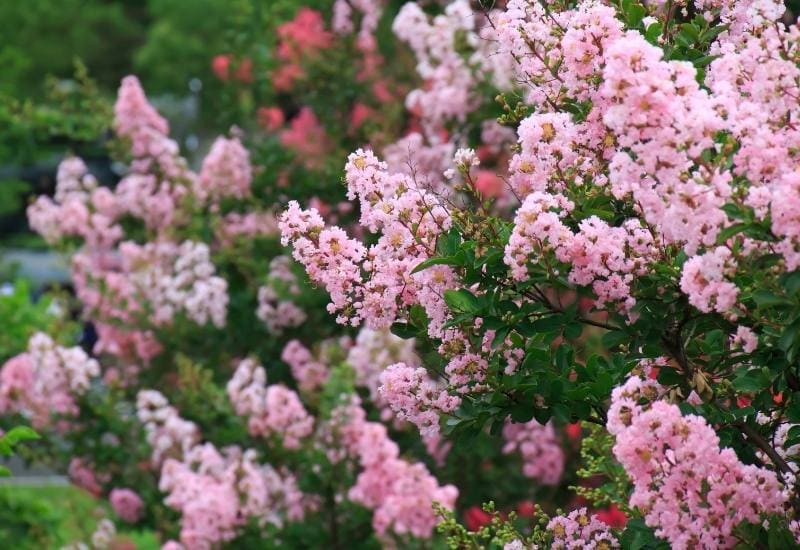
Crape myrtle grows fast and upright, with regularly positioned branches and very thick foliage. This a alone gives you privacy, but then you also get an extra bonus: massive blooms with thickly packed inflorescences that are usually pink to magenta, but they can also be white, red, purple or rose, depending on the variety.
The foliage is glossy and it will drop in winter, but… Some variety add amazing colors: it is usually dark green (emerald to olive), yet ‘Cherry Dazzle’ has a red to purple shade, while the award winning ‘Ebony Flame’ has black leaves and bright ted blooms. Ideal if you want a strong effect.
Crape myrtle comes in dwarf varieties (up to 3 feet , or 1.5 meters) and large ones, which are ideal for big view blocks in fairly spacious gardens, but only informal ones.
4: Beautyberry (Callicarpa americana)
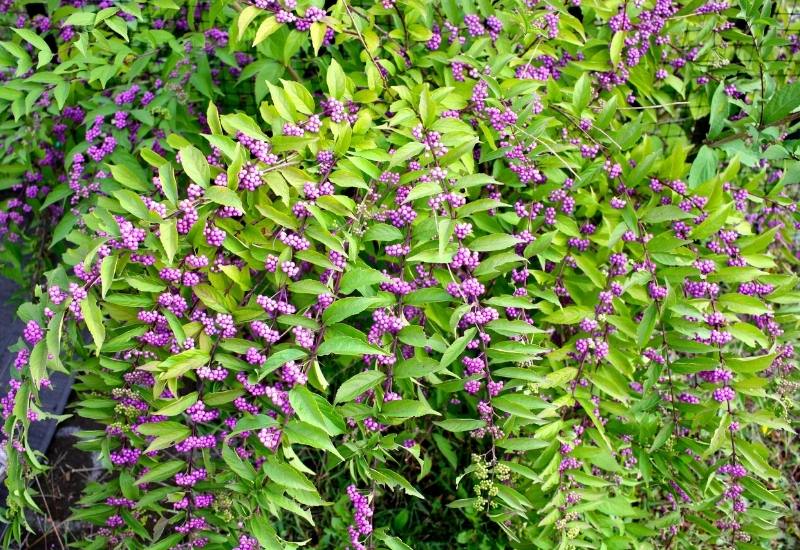
Beautyberry shrubs will shield you from prying eyes fast and, well, the name says it: with beauty. The branches are long and thin, filled with broad, mid green leaves that start in spring and cover the bush till late fall.
They arch, almost coming back to the ground, and they fill with white, pink or violet flowers in summer.
But this plant is bette known for the amazing violet purple berries that follow them in decorative clusters in fall. And it will fill with butterflies, pollinators and birds as well.
Beautyberry has a herbaceous look that makes it suitable to informal and traditional gardens, like English country or cottage gardens; it is easy to grow and low maintenance and it looks really great in naturalized settings.
5: Mock Orange (Philadelphus coronarius)
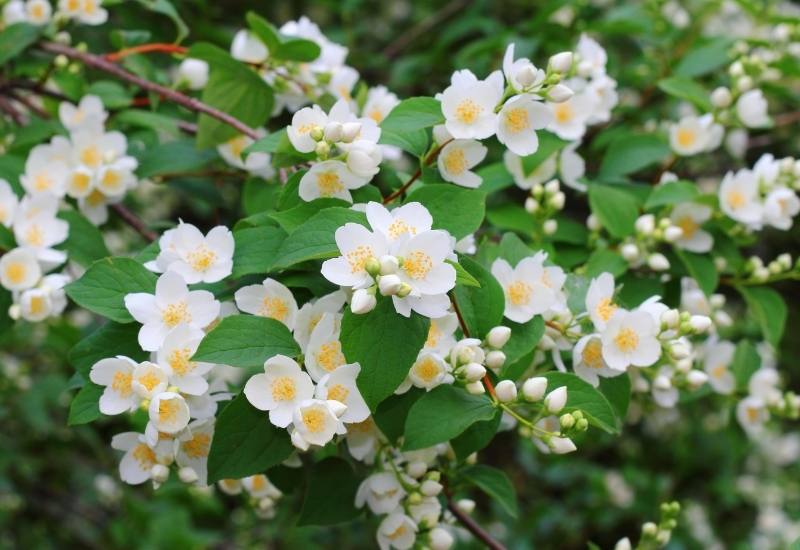
Mock orange is a fast growing deciduous shrub that takes its citrus smelling blooms. They don’t loom at all like “zagare” the flowers of orange trees, but they are still beautiful;
they come in in small groups of white blossoms at the end of branches, showy and with four petals each.
The foliage is broad and mid green, serrated, curved and pointed elliptical, and it is dense enough to stop any curious eye…
In winter, you will be able to enjoy the pale brown branches, waiting for the warm season to come back.
Mock orange is a well known shrub for its fragrance and beauty, it gives you that idea of “fruit tree blossom”,
looking a bit like apple trees, but it has a bushy shape that suits an informal garden, especially one that hearkens back at traditional and country designs, even if it is in an urban or suburban area.
6: Lilac (Syringa vulgaris)
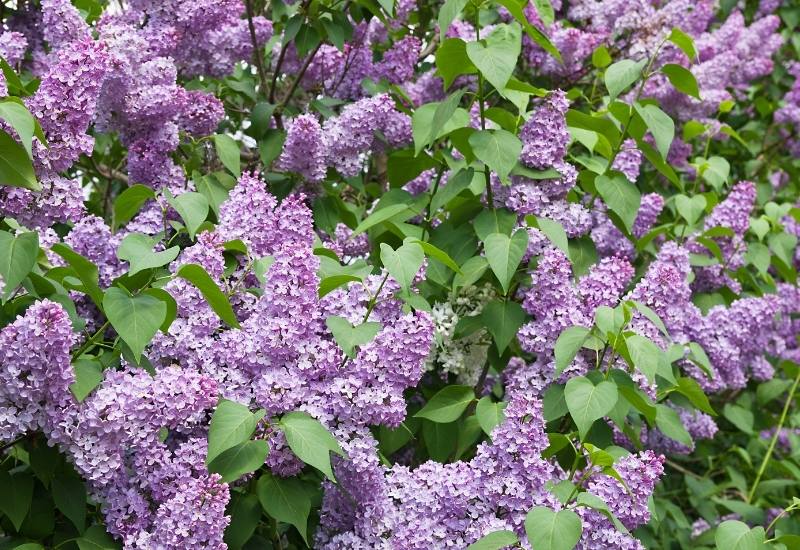
Everybody knows lilac shrubs, and they do grow fast and strong to give you full privacy in a short time.
Of course, this plant is famous for its spikes of lilac, pink, magenta or almost white flowers, and there are reblooming varieties like ‘Josee’ that keeps blossoming from late spring to frost.
The color display is accompanied by dense and mid green foliage, which makes looking through these shrubs impossible.
Lilac is a must in country and informal gardens; the blooms are massive and the plant, great for foundation planting as well as fir hedges, screening or borders. It is low maintenance, and quite strong, so, ideal for a fresh, colorful but private corner.
7: Beauty Bush (Kolkwitzia amabilis)
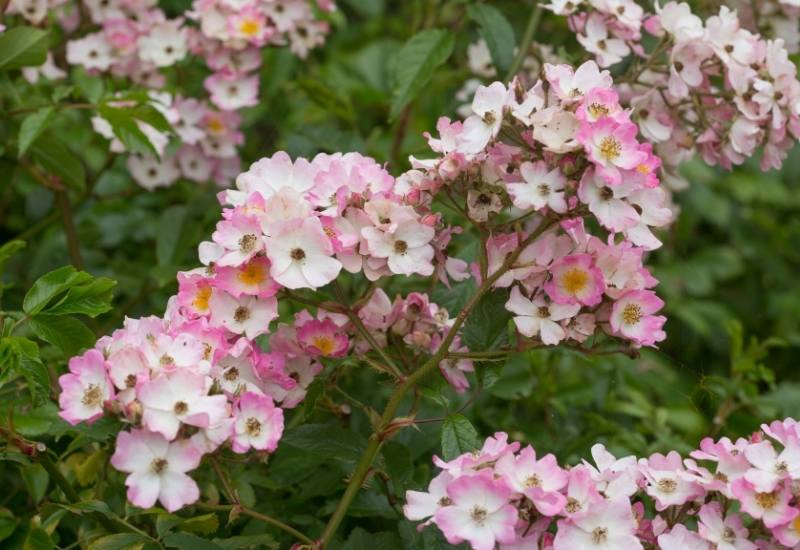
Beauty bush is a fast growing deciduous shrub with a round habit, and a great look! The foliage is mid green and it appears on the elegant and arching branches in spring…
But before you can actually see it well, you will have a wonderful spectacle of light rose flowers, loads of them! The whole plant will turn into a romantic cloud of pastel pink, and each flower has a darker, brighter center when you look at it close by.
When the blossom is spent, pink to brown capsules stay on the branches for months, while the leaves grow and form a green shipped from onlookers.
Low maintenance and strong, beautybush is also a fairly large shrub, which looks great in informal, natural looking and cottage gardens.
8: Hazelnut (Corylus spp.)
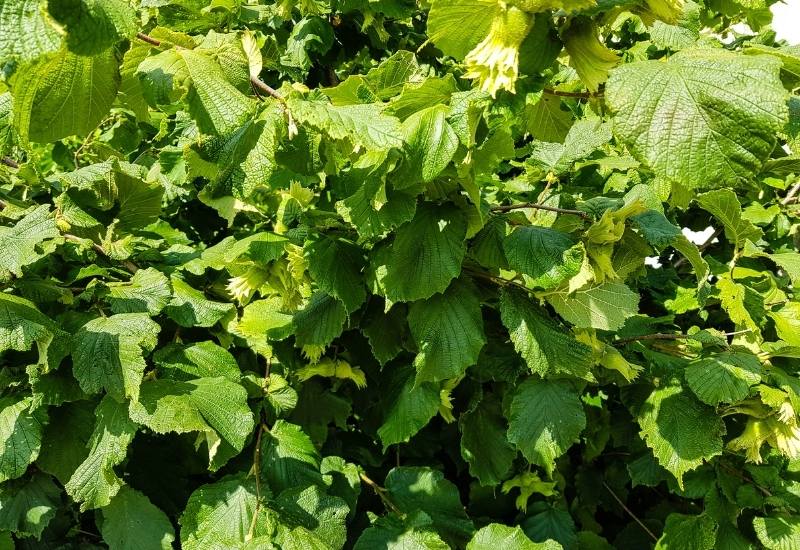
Hazelnut is a fast growing, bushy deciduous shrub, and it is the one that gives us the famous nuts too. Abundantly.
I personally recommend it for soil improvement, as it has loads of leaves, broad and green, that feed the soil when they drop at the end of fall, also giving you natural mulch.
The plants have an oval habit, which fill with catkins in late winter (like flowers, but they look like fluffy tails).
They will attract loads of pollinators too, bringing your garden to life. And in late summer or early fall you can actually harvest loads of hazelnuts, without jealous neighbors looking on!
Hazelnut is a great hand in any garden, informal in design, and it is also ideal for wilder, naturalized places; if you have a large plot, you can use it to get sheltered rooms where you are literally cut off from the rest of the world.
9: Serviceberry (Amelanchier alnifolia)
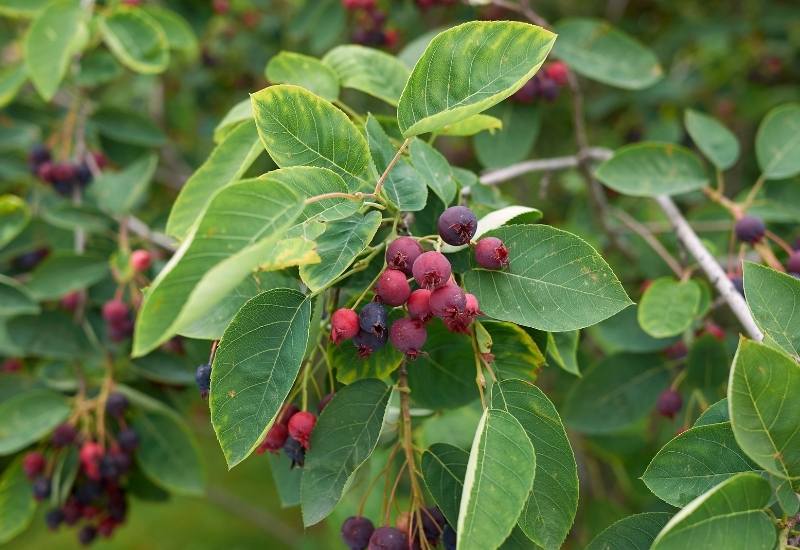
Serviceberry is a deciduous flowering shrub with an en habit. This makes it ideal for “partial screens”, which allow light into your garden while they discourage passers by from looking in. It provides interest all year round as well.
The clusters of white and fragrant flowers will bloom in mid spring, while the branches are naked. Then, it will grow small oval, light green leaves that stay on till frost, but nit before they greet you with a final blush of red.
The berries will give you a playful element with their orange color which turns red in summer, attracting lots of birds! In winter the elegance of the branches will give you a living statue to display.
Serviceberry is great as a specimen, but also in clumps, or in hedges and wind (or view) screens. Easy to grow and fast, it suits any informal design… It is also very cold hardy too, so, ideal for the northern states and Canada.
10: Burning Bush (Euonymus alatus ‘Compactus’)
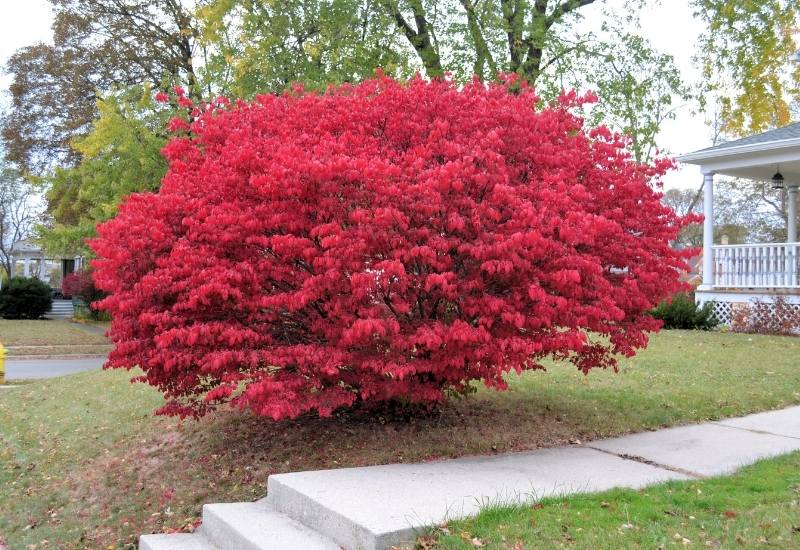
With burning bush you will have a fiery red deciduous shrub that grows fast and keeps prying eyes off your property. The plant has a round habit, with straight branches that grow out and almost horizontal to the ground.
The oval leaves hang on them in opposite pairs. But what will strike you (and those who see it from the other side) is the super bright scarlet and ruby red foliage in the fall.
The rest of the year, the foliage is green, and when they fall, the branches are so elegant and dark that they still provide interest.
Then, in spring you will get little green flowers, followed by purple to red fruits. Its beauty has won it the Award of Garden Merit by the Royal Horticultural Society.
Burning bush is highly decorative, so it will adapt to a wide range of designs. It can add vibrancy to informal borders and hedges, but even in formal and urban gardens it can put in quite a show!
11: Irish Juniper (Juniperus communis ‘Hibernica’)
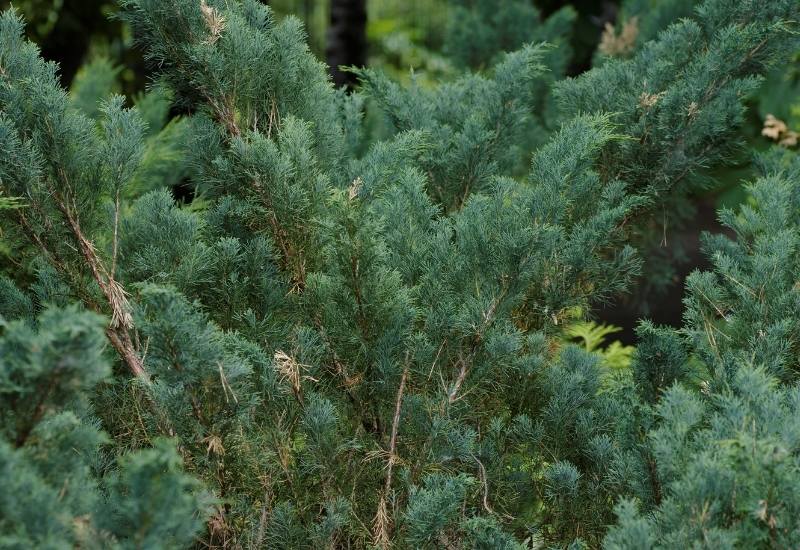
Irish juniper is a fast growing evergreen shrub that’s ideal to block view lines. It has upward pointing branches with prickly and pale green needles.
But it’s the shape that make it perfect. It grows fast into tall columns with super thick branching and foliage.
You can stop the view from window that looks into your private garden with great precision, with this lovely conifer.
And you can do it all year round! This is a strange variety, in the Nineteenth Century it used to have a round habit, but then it just.. changed! It is a receiver of the Award of Garden Merit by the Royal Horticultural Society.
Irish juniper is perfect for formal gardens and terraces; its shape is very sculptural and you can improve it with light pruning.
But even in an informal setting it will loom good if mixed with other plants to make it appear less “geometrical”.
12: Oakleaf Hydrangea (Hydrangea quercifolia)
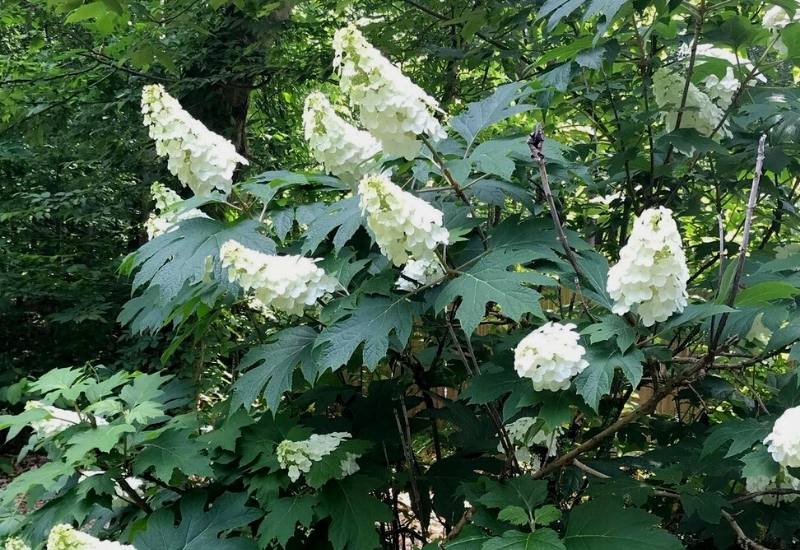
Oakleaf hydrangea grows its big leaves at high speed, and they can be 8 inches across (80 cm); they are deeply lobed, hence the name, and they start off light green in spring, them mud green, and they close the year with copper and red shades.
The conical spikes of start off in late spring, pointing out and up from the foliage. And they will stay with you for months, at first, they are rosy white, but they get darker and darker as days get longer and hotter and by the end of summer, they are brown! Each inflorescence can be 1 foot long (30 cm)!
Oakleaf hydrangea has a lush look and thick foliage, which makes it perfect for tall borders or to block off undesired eyes.
It is best in informal gardens, but its foliage makes it suitable for exotic and tropical themes as well.
13: Purple Chokeberry (Photinia floribunda)
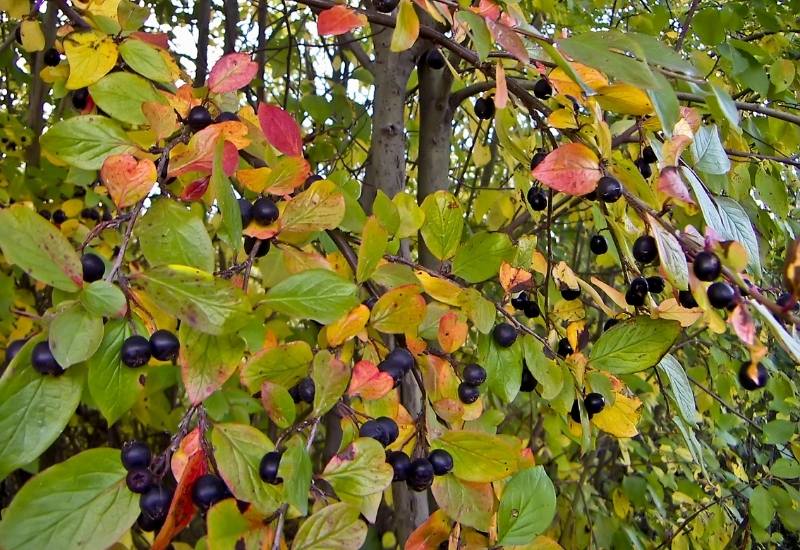
Purple chokeberry is a deciduous flowering shrub that will grow fairly fast into considerable size, blocking off a large part of your garden from view.
It has oval, glossy and mid green leaves, which will intersperse with clusters of delicate looking round clusters white flowers with five petals that look a bit like those of pear trees.
These will attract pollinators, then, the petals fall, it’s the turn of birds. Yes, because black and shiny berries will hang from the dark branches. And these look great in fall, against the yellow, orange and red foliage.
The long leaves of purple chokeberry provide a shield from viewers in good size informal and traditional gardens, especially those with a temperate look, and in fact it is a fairly cold hardy shrub you can grow where winters are severe.
14: Island Marlberry (Ardisia escallonoides)
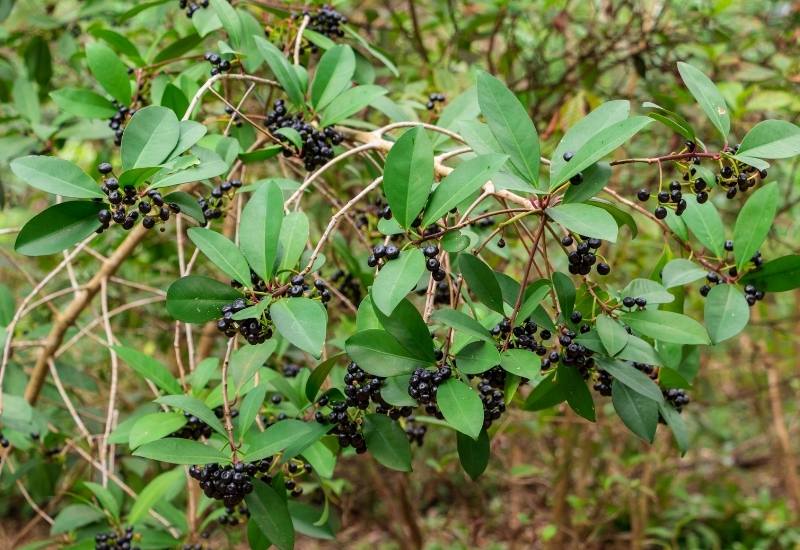
Island marlberry is an evergreen shrub that grows both fast and tall! The foliage is fairly dense, but not impenetrable, oval and glossy, dark green.
They come on tender looking and arching branches, and they are accompanied by little cream white flowers with golden anthers intermittently from early spring to frost! And they are fragrant too!
They produce shiny, round red berries which become black as they ripen. And when they are ripe, you can eat them too! The foliage will stay on in winter too, so this plant gives you privacy all year round.
Island marlberry is a tough and strong shrub that you could even train into a tree. It is perfect for natural looking gardens and naturalized areas;
it can give you shade as well as protection from curious eyes, fast, safely and on a large scale! Coastal gardens are perfect for it…
15: Japanese Andromeda (Pieris ‘Brouwer’s Beauty’)
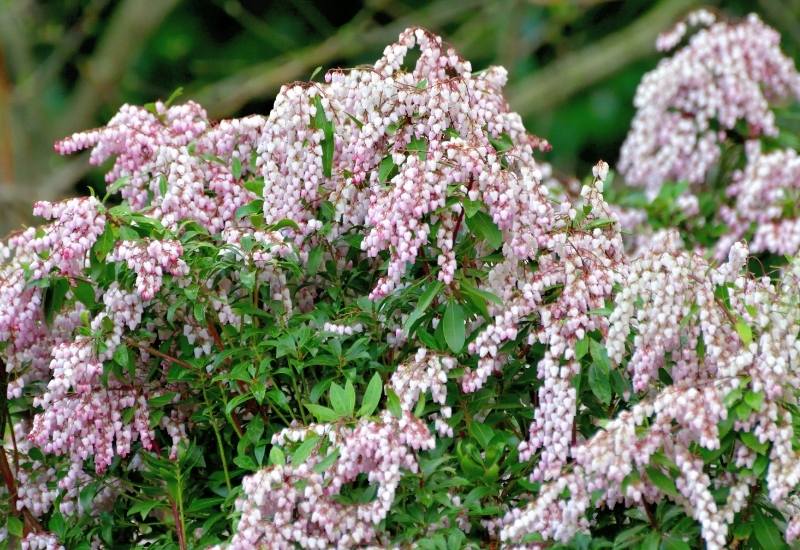
Japanese Andromeda is a fast growing evergreen shrub with beautiful foliage and blooms. Related to the more famous mountain Andromeda, it grows bugger and faster though.
The flossy and long leaves will cover the whole plant all year round, making a perfect screen for you and your family.
But this plant is also famous for its massive spring blooms… Many white urn shaped small flowers will hang from long stems in thick and big clusters, attracting pollinators and butterflies galore.
Onlookers will only wonder what’s happening beyond the thick foliage and white blossoms, while you will enjoy your garden life in peace and with a spot of fresh shade.
Japanese Andromeda is a showy shrub for informal, traditional but also urban and suburban gardens. It is very low maintenance but it gives you so much, including a peaceful life…
Fast Growing Shrubs Will Protect Your Privacy
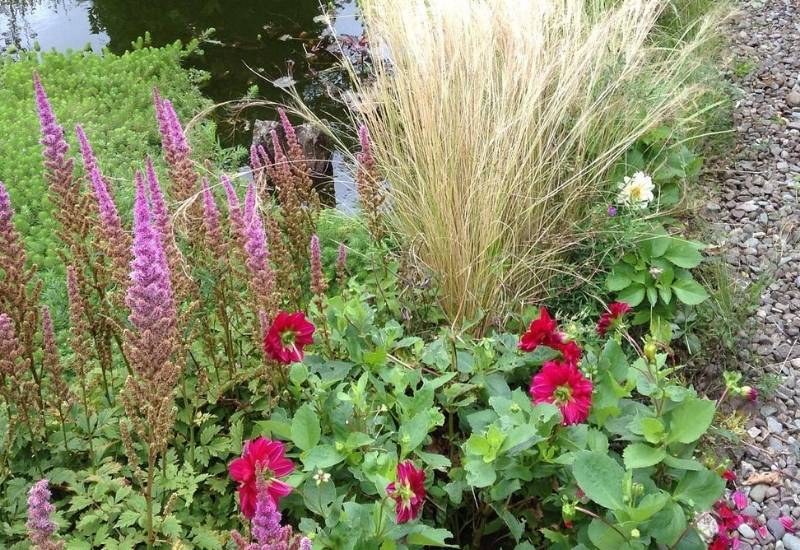
Welcome to the end of this journey, from now on, thanks to our tips and one or more of these great fast growing shrubs, you can live your life in your garden with ease, and without intruding eyes bothering you. So, well, I’ll leave you in peace too, till the next article, of course…

Written By
Adriano Bulla
After many years as an academic in London, Adriano Bulla became a writer, publishing books like A History of Gardening, Organic Gardening and Elements of Garden Design; he then decided to become a gardener, following his childhood dream, and has been following his dream writing and gardening professionally in Southern Europe, where he has specialized in new and innovative organic gardening fields and techniques, like permaculture, regenerative agriculture, food forests and hydroponics.
